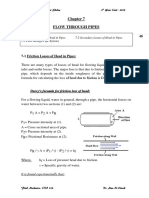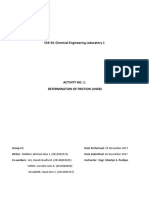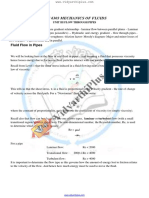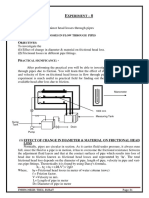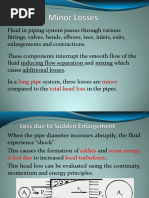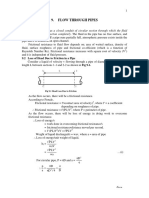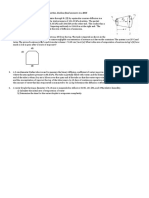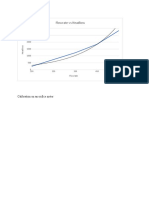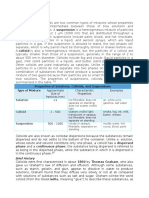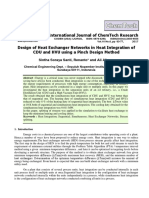Flow of Incompressible Fluids in Conduits and Thin Layers
Flow of Incompressible Fluids in Conduits and Thin Layers
Uploaded by
Carlo HafallaCopyright:
Available Formats
Flow of Incompressible Fluids in Conduits and Thin Layers
Flow of Incompressible Fluids in Conduits and Thin Layers
Uploaded by
Carlo HafallaOriginal Description:
Original Title
Copyright
Available Formats
Share this document
Did you find this document useful?
Is this content inappropriate?
Copyright:
Available Formats
Flow of Incompressible Fluids in Conduits and Thin Layers
Flow of Incompressible Fluids in Conduits and Thin Layers
Uploaded by
Carlo HafallaCopyright:
Available Formats
Lecture Notes in Fluid Mechanics
Compiled by: Engr. Cristine Bautista – Domingo
Chapter 5
Flow of Incompressible Fluids in Conduits and Thin Layers
This chapter deals with the steady flow of incompressible fluids through closed pipes and channels.
A. Shear Stress and Skin Friction
Fluid friction – defined as any conversion of mechanical energy to heat in a flowing stream
- appears in boundary layers because the work done by shear forces in maintaining the velocity gradients in
both laminar and turbulent flow is eventually converted into heat by viscous action.
(a) Skin friction - friction generated in unseparated boundary layers
(b) Form friction – additional energy dissipation that appears within the wakes when boundary layers separate
Consider flow of fluid through a straight horizontal pipe:
Pt. a Pt. b
Pa + gZa + a Va2 + Wp = Pb + gZb + b Vb2 + hf
gc 2 gc gc 2 gc
Since : Za = Zb,
Va = Vb ;
Wp = 0
Then: hf = Pa – Pb = Ps (where: Ps = pressure loss due to skin friction )
Where: hf = hf s = skin friction
= friction loss due to contact between a solid wall and a fluid stream
= 4 w L ( where: w = wall shear )
D
NOTE: If boundary layer separation occurs, hf is greater than hf s
B. Fanning Friction Factor, f :
- The Fanning friction factor is defined as the drag force per wetted surface area (shear stress at the surface) divided by the
product of density and velocity head.
- The fanning friction factor relates only to skin friction
f = 2w but hf s = 4 w L = 2w ( 2 L V2 )
V2 D V2 D
Thus: hf s = 4 f L V2
2D
C. Pressure Drop and Friction Loss in Laminar flow:
32 v( L2 − L1 )
Hagen-Poiseuille: Ps =
D2
But: hf s = 4 f L V2
2D
4 f L V2 = Ps = 32 (L2 –L1)
Lecture Notes in Fluid Mechanics
Compiled by: Engr. Cristine Bautista – Domingo
2D D2
Then : f = 16 but Re = DV
DV
f = 16
Re
D. Pressure Drop and Friction Loss in Turbulent
hf s = 4 f L V2 where: f = ( , Re ) - figure 6.9 (Perry’s Handbook)
2D
P s = 4 f L V2
2D
E. Friction Losses in Expansion, Contraction and Pipe Fittings
Skin friction losses in flow through straight pipe are calculated by using the Fanning friction factor. However, if the velocity of the fluid is
changed in direction or magnitude, additional friction losses occur. This results from additional turbulence which develops because of
vortices and other factors.
1. Sudden enlargement (expansion) losses
If the cross-section of a pipe enlarges very gradually, very little or no extra losses are incurred but if the change is
sudden, it results in additional losses due to eddies formed by the jet expanding in the enlarged section.
hf e = Ke Va2 where: Ke = expansion loss coefficient = [ 1 – (Sa/Sb) ]2
2gc Va = average velocity in the smaller upstream pipe
S = cross-sectional area
2. Sudden contraction losses
When the cross-section of the pipe is suddenly reduced, the stream cannot follow around the sharp corner, and
additional frictional losses due to eddies occur.
hf c = Kc Vb2 where: Kc = contraction loss coefficient = 0.5 [ 1 – (Sb/Sa) ]
2gc Vb = average velocity in the smaller downstream pipe
S = cross-sectional area
3. Losses in fittings and Valves
Pipe fittings and valves also disturb the normal flow lines in a pipe and cause additional friction losses. In a short pipe with many
fittings, the friction loss from these fittings could be greater than in the straight pipe.
hf f = Kf Va2 where: Kf = loss factor for the fitting ( table 6.4, p.6-18, Perry’s HB)
2gc Va = average velocity in pipe leading to the fitting
F. Flow Through Non-Circular Cross-sections
PROBLEMS:
Lecture Notes in Fluid Mechanics
Compiled by: Engr. Cristine Bautista – Domingo
1. Calculate the frictional pressure drop in pascal for olive oil at 293 K through a commercial pipe having
an inside diameter of 0.0525 m and a length of 76.2 m. The velocity of the fluid is 1.22 m/s. Is the flow
laminar or turbulent? Use the friction factor method. For olive oil, density = 919 kg/m3; viscosity = 84
x 10–3 Pa.s
2. A liquid having a density of 801 kg/m3 and a viscosity of 1.49 cP is flowing through a horizontal straight
pipe at a velocity of 4.57 m/s. The commercial steel is 1 ½ -in. Schedule 40. For a length of 61 m,
calculate (a) friction loss (b) for a smooth tube of the same diameter, calculate the friction loss (c) what
is the % reduction?
3. Water at 60F is pumped from a reservoir to the top of a mountain through a 6-in Schedule 120 pipe at an
average velocity of 12 ft/s. The pipe discharges into the atmosphere at a level of 3000 ft above the level
in the reservoir. The pipeline itself is 4500 ft long. If the overall efficiency of the pump and the motor
driving it is 70% and the cost of electric energy to the motor is 4 cents per kW-hr, what is the hourly
energy cost for pumping this water?
4. A centrifugal pump takes brine from the bottom of a supply tank and delivers it into the bottom of another
tank. The line between the tank is 600 ft of 4 –in schedule 40 pipe. The flowrate is 400 gal/min. In the
line are two-gate valves, four standard tees, and four ells. What is the energy cost for running this pump
for one 24-hr day? The specific gravity of brine is 1.18, the viscosity of brine is 1.2 cP and the energy
cost is $400 per hp-year on a basis of 300 days per year. The overall efficiency of the pump and motor
is 60%.
5. Hot water in an open storage tank at 82.2C is being pumped at the rate of 0.379 m3/min from this storage
tank. The line from the storage tank to the pump suction is 6.1 m of 3-in.schedule 40 steel pipe and it
contains three elbows. The discharge line after the pump is 61 m of 2-in.pipe and contains two elbows.
The water discharges to the atmosphere at a height of 6.1 m above the water level in the storage tank.
(a) Calculate all frictional losses
(b) Calculate the pump work in J/kg
(c) What is the kW power of the pump is the efficiency is 75%?
6. Find the cost per day of operating the pump motor in the system shown below:
Constant level water tank
4-in. Sched. 40
200 ft
water reservoir 6-in. Sched.40
The piping system consists of 200 ft of 6-in Schedule 40 steel pipe containing two-90 elbows and one open gate
valve from the reservoir to the pump; 6-in. Schedule 40 pipe follows the pump for 75 ft after which the pipe is
reduced to 4 –in schedule 40 steel pipe for 250 ft to the tank. The 4-in. pipe contains one gate valve and three-90
elbows. The efficiency of the pump-motor assembly is 60 percent. The cost for electrical energy is $400 per Hp-
yr on a basis of 300 days/yr. The water flow is to be maintained at 625 gal/min, and the water temperature is
assumed constant at 70F. Solve in fps system.
You might also like
- MA3006 Tutorial 7 SolutionDocument4 pagesMA3006 Tutorial 7 Solutionclarence limNo ratings yet
- Experiment 12 Fluid Friction 1Document4 pagesExperiment 12 Fluid Friction 1Shahid KhanNo ratings yet
- Chapter - 5 - Flow of Incompressible Fluids in Conduits and Thin LayersDocument4 pagesChapter - 5 - Flow of Incompressible Fluids in Conduits and Thin LayersAdelaida CruzNo ratings yet
- Flow Through PipesDocument29 pagesFlow Through PipesMichael TinambunanNo ratings yet
- 4th Sem - Mech Engg - Fluid Mechanics-P-1Document29 pages4th Sem - Mech Engg - Fluid Mechanics-P-1Narinder SharmaNo ratings yet
- Chapter5 - Analysis of Fluid Flow in Single Straight PipeDocument3 pagesChapter5 - Analysis of Fluid Flow in Single Straight Pipeahmad nafek august fouzyNo ratings yet
- Fluids - IvDocument29 pagesFluids - IvSam SawyerNo ratings yet
- Lecture 5 2Document15 pagesLecture 5 2IbrahimDewaliNo ratings yet
- Fluids - IIIDocument29 pagesFluids - IIINitin GandhareNo ratings yet
- Indo 1Document29 pagesIndo 1Michael TinambunanNo ratings yet
- Unit I Flow Through PipesDocument28 pagesUnit I Flow Through Pipeslovelylidhish143No ratings yet
- Student Handout 20 2014Document20 pagesStudent Handout 20 2014kietniNo ratings yet
- Fluids - IIIDocument9 pagesFluids - IIIPOONAM RANINo ratings yet
- DCC30122 - Fluids MechanicsDocument50 pagesDCC30122 - Fluids MechanicsHadif NuqmanNo ratings yet
- Act 1 Determination of Friction Losses GP 1Document13 pagesAct 1 Determination of Friction Losses GP 1Junn Edgar LibotNo ratings yet
- Act 1 Determination of Friction Losses GP 1Document13 pagesAct 1 Determination of Friction Losses GP 1Junn Edgar LibotNo ratings yet
- Turbulent FlowDocument40 pagesTurbulent Flowfaizifitri0211No ratings yet
- W1 - 1.1 Pipe FrictionDocument28 pagesW1 - 1.1 Pipe FrictionNur HalizaNo ratings yet
- Lec. 8 Pipes PDFDocument40 pagesLec. 8 Pipes PDFسامر فؤاد الشخريتNo ratings yet
- Module 2 Bernoulli's Equation - ME 319-ME32S3 - Fluid MachineriesDocument8 pagesModule 2 Bernoulli's Equation - ME 319-ME32S3 - Fluid MachineriesOkay Printing100% (1)
- Bernoulli's EquationDocument8 pagesBernoulli's EquationOkay Printing100% (1)
- Exp 1Document30 pagesExp 1Anusha AnuNo ratings yet
- H4 Head Loss - Friction Factor4Document10 pagesH4 Head Loss - Friction Factor4Jeremiah AgbajeNo ratings yet
- Hydraulics - Chapter 3Document8 pagesHydraulics - Chapter 3thuaiyaalhinaiNo ratings yet
- E4 Lab Sheet Minor Losses in PipeDocument17 pagesE4 Lab Sheet Minor Losses in PipeHoongNo ratings yet
- Chapter-12 PumpDocument39 pagesChapter-12 PumpSalehin AnamNo ratings yet
- Fluids U IIIDocument11 pagesFluids U IIIR Raj Singh SinghNo ratings yet
- Lab 9 - Friction in PipesDocument6 pagesLab 9 - Friction in PipesMelad HaweyouNo ratings yet
- Cve341lecturenotes1 220921133246 9aa9c294Document61 pagesCve341lecturenotes1 220921133246 9aa9c294Krishna P. YadavNo ratings yet
- Kantipur Engineering College: Department of Civil EngineeringDocument18 pagesKantipur Engineering College: Department of Civil EngineeringSudeep Kunwar75% (4)
- Friction in Pipes Aim:: FM&HM LabDocument7 pagesFriction in Pipes Aim:: FM&HM Labashoku2No ratings yet
- Ch8 Steady Incompressible Flow in Pressure Conduits (PartB)Document66 pagesCh8 Steady Incompressible Flow in Pressure Conduits (PartB)avinash_friends21No ratings yet
- Flow Characteristics:: B. Pressure Loss (Head Loss, PressureDocument4 pagesFlow Characteristics:: B. Pressure Loss (Head Loss, PressureLily NurdianaNo ratings yet
- F.M.H.M.PR.8,9,10 PracticalDocument15 pagesF.M.H.M.PR.8,9,10 PracticalnitinmiskeNo ratings yet
- (M4s2-Powerpoint) Head LossesDocument14 pages(M4s2-Powerpoint) Head LossesJOSHUA MEYER ANGELESNo ratings yet
- fluid friction experiment (manual)Document3 pagesfluid friction experiment (manual)Ahmed AlmashqbaNo ratings yet
- Fluid Mechanics and Pressure DropDocument33 pagesFluid Mechanics and Pressure Dropanon-56206100% (3)
- Unit Iv Boundary Layer: Sri Vidya College of Engineering & Tech Question Bank-Unit - IvDocument7 pagesUnit Iv Boundary Layer: Sri Vidya College of Engineering & Tech Question Bank-Unit - IvBahman JadidiNo ratings yet
- Fluid Friction in Pipes and Losses From Fittings: ObjectivesDocument4 pagesFluid Friction in Pipes and Losses From Fittings: ObjectivesOsamaNo ratings yet
- Apparatus For Friction Losses in Pipe Fittings ManualDocument17 pagesApparatus For Friction Losses in Pipe Fittings ManualShoaib PathanNo ratings yet
- Topic 4c Minor Losses Turbulent Flow in Circular Pipes 2021Document23 pagesTopic 4c Minor Losses Turbulent Flow in Circular Pipes 2021Nor SyamimiNo ratings yet
- 13 - Fluids at Rest and Piped FluidsDocument7 pages13 - Fluids at Rest and Piped FluidsVinay GuptaNo ratings yet
- Lecture-7-Energy Consideration+OrificesDocument49 pagesLecture-7-Energy Consideration+OrificesAbdul Waseh BhangooNo ratings yet
- 9.flow Through Pipes Jan 2015 PDFDocument25 pages9.flow Through Pipes Jan 2015 PDFburhanuddin100% (1)
- Chapter 4.1 - Flow in Pipe 1Document30 pagesChapter 4.1 - Flow in Pipe 1Lin YanNo ratings yet
- Fluid-Mechanics-Pipe-Flow-Chapter-VI-via BluetoothDocument20 pagesFluid-Mechanics-Pipe-Flow-Chapter-VI-via BluetootharphiltographyNo ratings yet
- Chapter 4 ADocument30 pagesChapter 4 AZahidahNo ratings yet
- 2 - EN-B2.3-ESE-Exp3 - Viscous Fluids-ExercisesDocument4 pages2 - EN-B2.3-ESE-Exp3 - Viscous Fluids-Exercisesalejangruerrero04No ratings yet
- Summary of Drinking Water Supply System: Chapter 2. Basic Principles of Pipe FlowDocument20 pagesSummary of Drinking Water Supply System: Chapter 2. Basic Principles of Pipe Flowaidah maqbulahNo ratings yet
- Exp 5 Head Loss Due To FrictionDocument17 pagesExp 5 Head Loss Due To FrictionnileshNo ratings yet
- Pipe Flow: Laminar Flow or Viscous FlowDocument34 pagesPipe Flow: Laminar Flow or Viscous FlowBalaguruNo ratings yet
- Transport PhenomenaDocument7 pagesTransport PhenomenannpeelaNo ratings yet
- Hydraulics Unit-V (4th Sem)Document26 pagesHydraulics Unit-V (4th Sem)Anthropophobe NyctophileNo ratings yet
- Friction LossesDocument34 pagesFriction LossesTaha100% (1)
- Flow Through Pipes Gate Notes 64Document8 pagesFlow Through Pipes Gate Notes 64dattu33No ratings yet
- MATERI - 7 Kehilangan EnergiDocument11 pagesMATERI - 7 Kehilangan EnergiSandro Nainggolan BrabNo ratings yet
- Feynman Lectures Simplified 2C: Electromagnetism: in Relativity & in Dense MatterFrom EverandFeynman Lectures Simplified 2C: Electromagnetism: in Relativity & in Dense MatterNo ratings yet
- Che 421A Clearly State The Sources of Substance Properties. Enclose Final Answers in A BoxDocument1 pageChe 421A Clearly State The Sources of Substance Properties. Enclose Final Answers in A BoxCarlo HafallaNo ratings yet
- Chapter 3 (Expt 8)Document2 pagesChapter 3 (Expt 8)Carlo HafallaNo ratings yet
- S Announcement 16221Document6 pagesS Announcement 16221Carlo HafallaNo ratings yet
- Flowrate Vs Headloss: Calibration On An Orifice MeterDocument1 pageFlowrate Vs Headloss: Calibration On An Orifice MeterCarlo HafallaNo ratings yet
- Equity TheoryDocument2 pagesEquity TheoryCarlo HafallaNo ratings yet
- Mystery." But Are We Even Sure That We Will Witness The Mystery of Tomorrow? IsDocument1 pageMystery." But Are We Even Sure That We Will Witness The Mystery of Tomorrow? IsCarlo HafallaNo ratings yet
- Disaster Prevention and MitigationDocument36 pagesDisaster Prevention and MitigationCarlo HafallaNo ratings yet
- 7 Disaster MitigationDocument23 pages7 Disaster MitigationCarlo HafallaNo ratings yet
- Colloidal DispersionDocument5 pagesColloidal DispersionCarlo HafallaNo ratings yet
- HeatDocument1 pageHeatCarlo HafallaNo ratings yet
- Philippine Economy Posts 7.1 Percent GDP Growth in The Third Quarter of 2016Document2 pagesPhilippine Economy Posts 7.1 Percent GDP Growth in The Third Quarter of 2016Carlo HafallaNo ratings yet
- Mass Transfer II (CH3006D) Assignment 1: T, K X yDocument2 pagesMass Transfer II (CH3006D) Assignment 1: T, K X ykeerthi srijithNo ratings yet
- Types of Screens: Primary TreatmentDocument20 pagesTypes of Screens: Primary TreatmentMadhuri GuptaNo ratings yet
- Design of A Sedimentation BasinDocument8 pagesDesign of A Sedimentation BasinCOLLEN KGAODINo ratings yet
- R 41031022015Document8 pagesR 41031022015GokulSubramanianNo ratings yet
- WKM Cameron ValvesDocument20 pagesWKM Cameron ValvesRolan Mart Sasongko100% (1)
- Duct Design SlidesDocument108 pagesDuct Design SlidesJugmohunNo ratings yet
- HMT IMP QuestionsDocument3 pagesHMT IMP QuestionsKaran HumbareNo ratings yet
- Warnings Grupo 3 HEC RAS 10 AÑOSDocument2 pagesWarnings Grupo 3 HEC RAS 10 AÑOSCamila FalconíNo ratings yet
- Storage TankDocument10 pagesStorage TankJherome ValenciaNo ratings yet
- QPDocument3 pagesQPgood buddyNo ratings yet
- 4.1.1 HAZOP Worksheet-Ammonia Unit-Raw - India ProjectDocument116 pages4.1.1 HAZOP Worksheet-Ammonia Unit-Raw - India Projectsafety pt pcsNo ratings yet
- NTF-DS-CV-001 Data Sheet Control Valve Rev.BDocument4 pagesNTF-DS-CV-001 Data Sheet Control Valve Rev.BRicardo NapitupuluNo ratings yet
- SRZS New Brochure 4-3-18Document3 pagesSRZS New Brochure 4-3-18Mohamed Abd RahmanNo ratings yet
- Exercise - FlashDocument5 pagesExercise - FlashKuat NNo ratings yet
- Mouvex Sls Series Flyer UsDocument2 pagesMouvex Sls Series Flyer UsrasottoNo ratings yet
- Chapter 12 Fluids AnswersDocument2 pagesChapter 12 Fluids AnswersKalenaSpinolaNo ratings yet
- BC Brochure Redura RodSealingSystem 12S WebDocument16 pagesBC Brochure Redura RodSealingSystem 12S WebgemagdyNo ratings yet
- A Review of Downhole Separation TechnologyDocument8 pagesA Review of Downhole Separation TechnologyIbrahim NugrahaNo ratings yet
- International Journal of Chemtech Research: Sintha Soraya Santi, Renanto and Ali AltwayDocument15 pagesInternational Journal of Chemtech Research: Sintha Soraya Santi, Renanto and Ali AltwayHoàng NhânNo ratings yet
- Computational Techniques in Civil Engineering Tutorials (Water Resources Part)Document6 pagesComputational Techniques in Civil Engineering Tutorials (Water Resources Part)yeee boiiiNo ratings yet
- 6 Well ControlDocument11 pages6 Well Controlahmed abdul razaqNo ratings yet
- Hoja de Cálculo en Threaded Coupling - EDITABLEDocument2 pagesHoja de Cálculo en Threaded Coupling - EDITABLETIPAZONo ratings yet
- Fluid Statics Using COMSOLDocument2 pagesFluid Statics Using COMSOLbekalubimrew11No ratings yet
- KLM Hydraulic Program OverviewDocument50 pagesKLM Hydraulic Program Overviewjoshimanan01No ratings yet
- Brake SystemDocument36 pagesBrake SystemGabriel AvilaNo ratings yet
- Mechanical Engineering: Advanced Computational Simulation inDocument2 pagesMechanical Engineering: Advanced Computational Simulation inSrashmiNo ratings yet
- Refrigeration SystemDocument37 pagesRefrigeration SystemSatish KumarNo ratings yet
- Laminar Flame Speeds of Ethanol, N-Heptane, IsooctaneDocument8 pagesLaminar Flame Speeds of Ethanol, N-Heptane, IsooctaneanilkoleNo ratings yet
- Paragon Maintenance System: 5.2.2 Inspection Interval Matrix - High Pressure - Low Pressure EquipmentDocument5 pagesParagon Maintenance System: 5.2.2 Inspection Interval Matrix - High Pressure - Low Pressure EquipmentOstap SepykNo ratings yet
- Example Solvent SwitchDocument5 pagesExample Solvent SwitchiheartshowNo ratings yet













